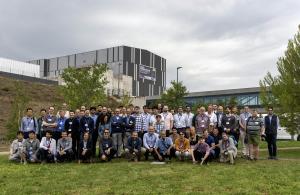IAEA Technical Meeting held to tackle tokamak disruptions
The detrimental effects of plasma disruptions are a major concern for ITER and all next-generation fusion devices. Experts from all over the world met early this month at ITER headquarters to exchange the latest, state-of-the-art findings on the consequences of disruptions, on identifying reliable methods for disruption prediction and on finding strategies for their mitigation.
The International Atomic Energy Agency (IAEA) fosters international collaboration and helps to close gaps in the physics and technology of nuclear fusion by organizing a series of conferences and technical meetings. The aim of the "Third Technical Meeting on Plasma Disruptions and their Mitigation" hosted by the ITER Organization from 3 to 6 September was to bring together experts from the IAEA's member states to exchange the latest understanding on consequences, prediction and avoidance, and mitigation.
The preparation of the meeting was overshadowed by the sad loss of ITER physicist Michal Lehnen, who was the chair of the meeting's Programme Committee and the leader of the ITER Disruption Mitigation System Task Force since its creation in 2018. Michael's pioneering work was mentioned in numerous presentations and tribute was paid to him in a dedicated talk by ITER's Richard Pitts, Experiments & Plasma Operation Section Leader. The large attendance of about sixty colleagues onsite and another twenty remote is a testimony to the importance of this research topic, to which Michael contributed significantly.
The Programme Committee had compiled a dense agenda, with 7 invited, 28 oral and 19 poster presentations. Ample time was reserved in four discussion sessions to target specific questions, for example the improvement of models for electromagnetic load calculations, optimum material injection parameters for disruption mitigation, and the best strategies for developing predictors that are universally applicable across existing and future tokamaks.
At the beginning of the meeting, members of the ITER Organization gave an update on the proposed ITER re-baseline, its implications on various aspects of disruptions, and an overview of the ITER disruption mitigation system (DMS) as it was presented at the final design review earlier this year.
The sudden release of the plasma's stored thermal and magnetic energy and the induction of significant currents into vessel components can have severe operational consequences for large tokamaks such as ITER and other future nuclear fusion facilities. Efforts are ongoing to develop physics models for assessing expected thermal and electromagnetic loads during such events. These physics models are validated using existing data from dedicated experiments on present-day tokamaks or purposely built devices. One good example is the recent improvement in modelling of runaway electron formation and the potential for damage induced by the impact of these runaways on plasma-facing components during the disruption current quench phase.
To protect machine components from excessive heat loads and electromagnetic forces and to ensure an effective execution of the Research Plan, ITER will install a disruption mitigation system based on shattered pellet injection technology. Over the last few years, the technology has advanced to a level that allows for reliable disruption mitigation and extensive experimental campaigns have been carried out on several tokamaks (see reports here and here for example) to support DMS final design and to prepare for its operation. To a significant extent, it has been the work performed within the Disruption Mitigation System Task Force which has driven the technology developments. The enormous amount of data and modelling helps to reduce the uncertainty in predicting the effectiveness of massive material injection for disruption mitigation. In parallel, alternative methods—particularly for runaway electron dissipation—are being studied.
Disruption mitigation will only work if the occurrence of these events can be predicted reliably during a plasma pulse. This requires the use of real-time detection systems, which employ a large number of sensors to monitor the plasma state and stability limits. The last years have seen a strong step forward towards detectors of imminent disruptions that incorporate physics models executed in real-time and towards the application of machine learning methods. The high success rates of current disruption predictors, with several examples reported at the IAEA meeting, give confidence that a robust system will be available for ITER to implement an effective disruption avoidance scheme reasonably quickly once operation begins.



